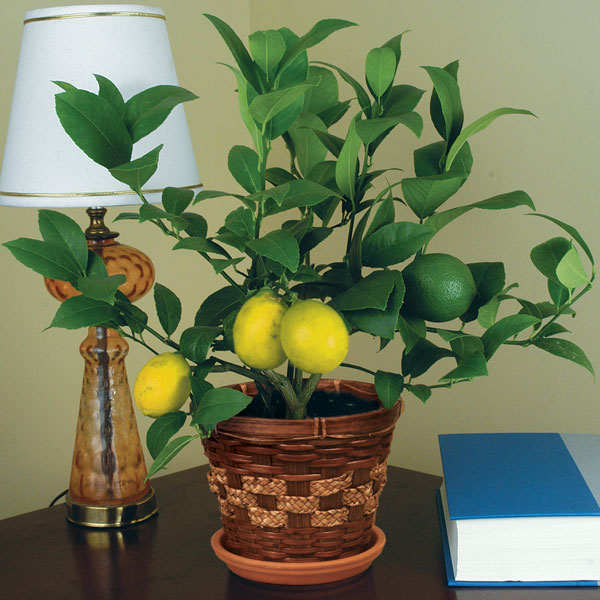Citrus Overview
For thousands of years, gardeners have grown citrus in pots, both for the beauty of their fragrant flowers and for the reward of fresh, homegrown fruit. Whether you live in a warm, tropical zone or a northern climate where plants need to come indoors for the winter, citrus trees adapt surprisingly well to containers. With the right care, anyone can enjoy lemons, limes, oranges, and kumquats—even on a patio, balcony, or sunny windowsill.
Below you’ll find the essential steps for success, from choosing containers to fertilizing and pruning.
Light and Temperature Needs
Sunlight is the single most important factor in growing citrus. These trees need a minimum of 6–8 hours of direct sun daily, and more is always better. Indoors, place them by the brightest south-facing window or supplement with grow lights.
Citrus also prefers warmth. Temperatures above 65°F encourage strong growth, though many varieties can tolerate short dips below freezing. For instance, mandarins can withstand 20°F, and Meyer lemons and kumquats are among the more cold-hardy citrus. Still, in cooler climates, plan to move container citrus inside before frost arrives.
Choosing the Right Container
Citrus can thrive in different types of pots—plastic, glazed ceramic, wood, cement—but terra cotta (clay) is often the best choice. Clay pots breathe, allowing the soil to dry more evenly and reducing the risk of root rot. Containers that retain too much moisture can encourage fungal problems and eventually kill the plant.
Size matters too: don’t choose a pot that’s excessively large for the root ball. Citrus actually prefer to be somewhat root-bound, and a pot that’s too big can cause soggy soil. Surprisingly, even productive Meyer lemons can thrive for years in an 8-inch pot.
Soil and Watering
A well-drained, soil-less mix is ideal. A blend of peat moss, perlite, vermiculite, and composted bark works well, with limestone added to keep the pH around 6. What matters most is drainage.
The leading cause of failure with potted citrus is overwatering. Always allow the top of the soil to dry before watering again, and don’t be afraid to let the plant show the slightest wilt before giving more water. The goal is to keep the roots evenly moist but never saturated.
Feeding Citrus Trees
Citrus are heavy feeders and need consistent nutrition to produce strong growth and sweet fruit. Balanced or slow-release fertilizers work well, as do organic blends made specifically for citrus. Many gardeners use products that combine natural ingredients like kelp, bone meal, and rock phosphate with beneficial soil microbes.
Timing is key:
- Feed regularly during the active growing season (spring through summer).
- Reduce or stop feeding in late summer to allow new growth to harden off before winter.
- Resume fertilizing once new growth appears in late winter or early spring.
Watch for nutrient deficiencies—yellowing between the veins of young leaves often signals iron chlorosis. This can be corrected with a chelated iron supplement, applied as a foliar spray or in the soil.
Pest/Disease Problems
Citrus trees can sometimes attract pests like scale, spider mites, and mealybugs, especially when they’re brought indoors at the end of summer. To prevent infestations from taking hold, apply neem oil twice about a week apart before transitioning your plant inside. This is particularly helpful if you’ve had recurring issues with mealybugs or scale in the past. Spider mites are another common hitchhiker; they often go unnoticed outdoors but can multiply rapidly once exposed to the dry indoor air of winter. As for root problems, these usually arise only when plants are kept too wet in cool, damp conditions. Using a clay pot and allowing the soil to dry slightly between waterings will go a long way in keeping the roots healthy. Grafted plants grown on disease-resistant rootstock are also less likely to suffer from root diseases.
Pruning and Shaping
Citrus trees generally need little pruning, but occasional trimming helps maintain a tidy, well-shaped plant. Prune young trees strategically to encourage a strong framework. For mature trees, remove wayward or overly tall branches that disrupt the shape.
The best time to prune is right after fruit harvest, since late-summer growth often holds the buds for the next season’s crop. Over-pruning at the wrong time can reduce the following year’s fruit set.
Enjoying the Harvest
One of the greatest joys of container citrus is the journey, not just the fruit. You’ll experience waves of intensely fragrant blooms, watch the fruit slowly change color, and eventually enjoy the unbeatable flavor of citrus picked from your own plant. Depending on the variety, you might even enjoy multiple bloom-and-fruit cycles each year.
Grafted Plants
When citrus trees are grafted, it’s common for new shoots to sprout from the rootstock below the graft union. These vigorous shoots should be removed promptly, as they can outcompete the grafted variety and stunt its growth. If left unchecked, the rootstock may take over, leaving the desired citrus variety weak or undersized. Fortunately, as the tree matures, this tendency to sucker from the rootstock usually decreases or stops altogether.
Final Thoughts
Growing citrus in containers is rewarding for gardeners of all skill levels. With plenty of sunlight, careful watering, the right soil mix, and thoughtful feeding, you’ll be rewarded with healthy plants and abundant harvests. From Meyer lemons to kumquats and mandarins, citrus trees bring beauty, fragrance, and flavor to any home or garden—no matter the climate.
Watch our video below to learn more about Citrus Tree care and propagation:
Summer Rayne Oakes is an author, eco-activist, and plant enthusiast who currently has more than 1,000 house plants in her Brooklyn, NY apartment. We had the pleasure of visiting with Summer Rayne at Logee's to talk about citrus tree care and propagation. In the video below, she and Logee's owner, Byron Martin, discuss general citrus care tips, pitfalls and propagation. You can learn more about Summer Rayne at her blog Homestead Brooklyn and her 'Plant One On Me' YouTube channel where she helps people reconnect with nature.

